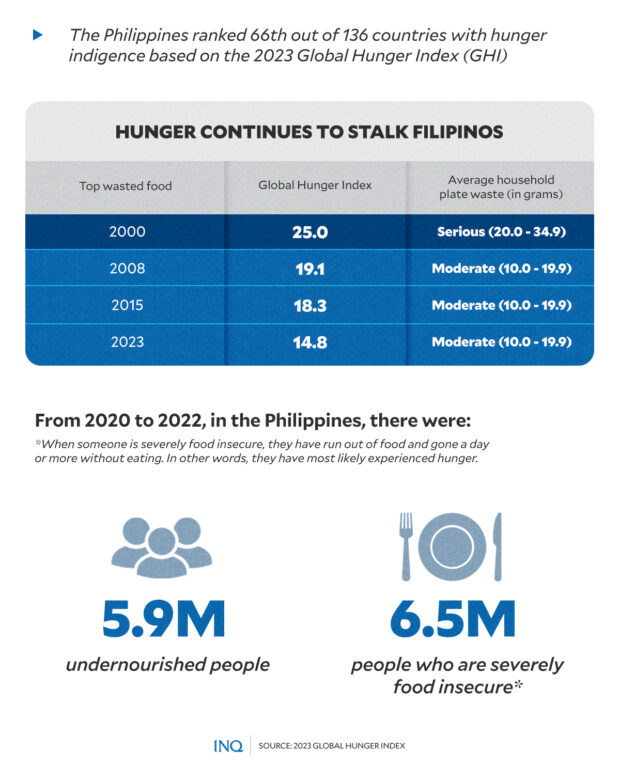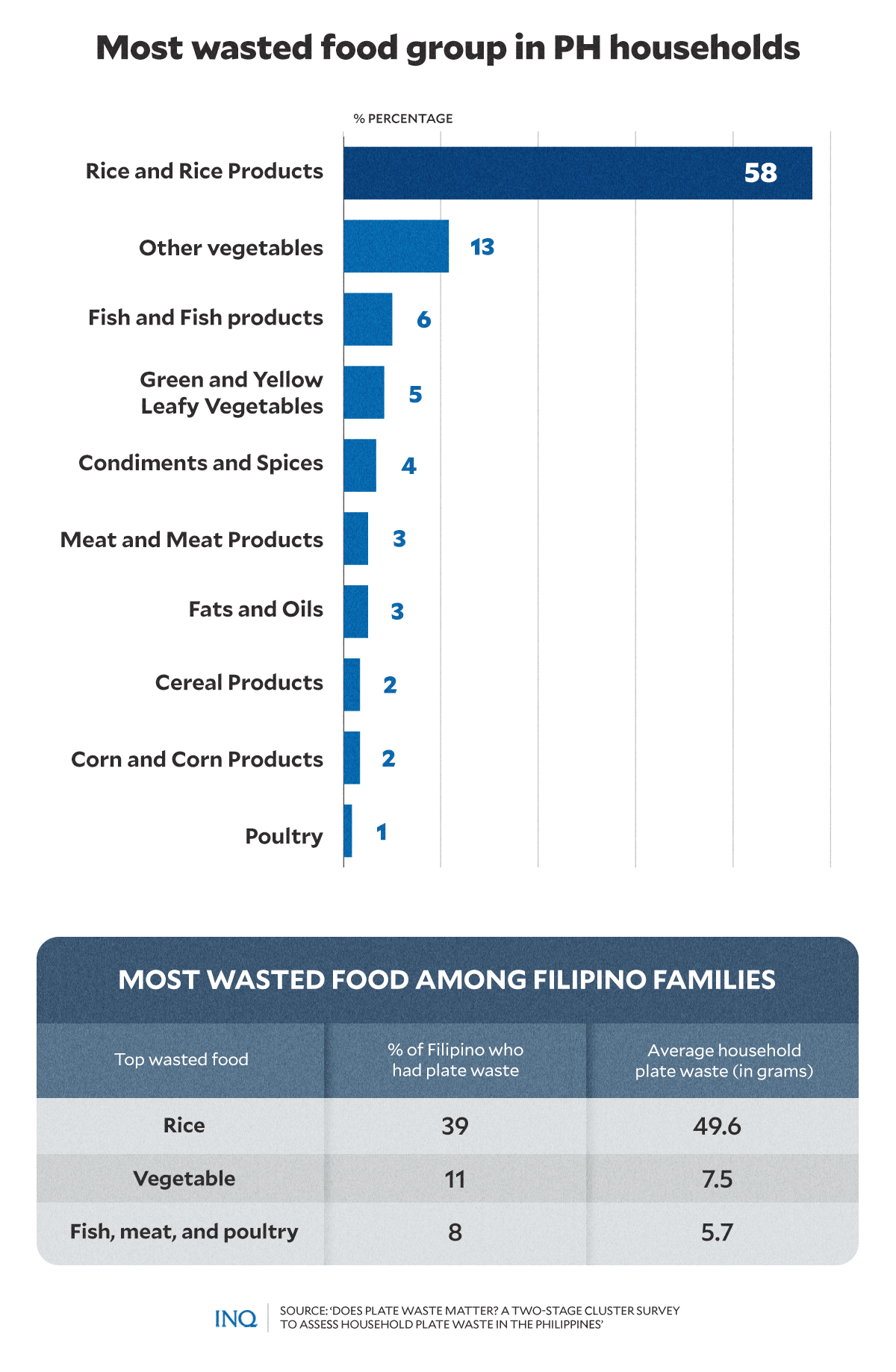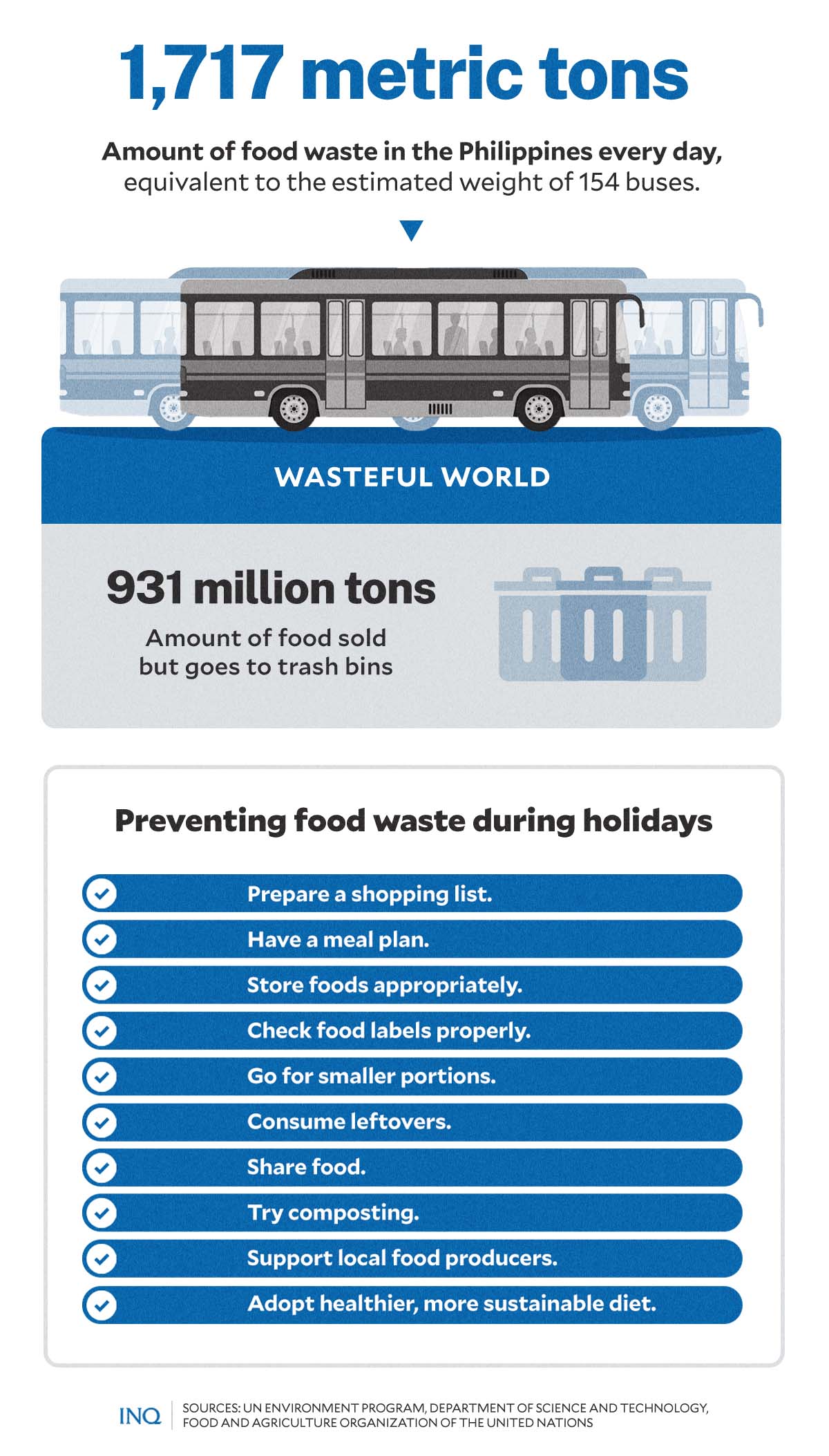Food for thought: Public urged to reduce food waste during festive season
MANILA, Philippines—Participating in a cherished tradition, many Filipino families take great pride in preparing an array of sumptuous dishes for their Christmas Eve feast, known as Noche Buena. This festive occasion is a culinary delight and a celebration of family bonds and cultural heritage.
In the Philippines, Noche Buena is celebrated with a variety of popular dishes, including Christmas ham, puto bumbong, fruit salad, and the uniquely Filipino-style spaghetti. These culinary delights have gained international recognition for their festive flavors and cultural significance.
In 2021, Taste Atlas, a global food database, acknowledged four Filipino Noche Buena favorites — lechon, bibingka, lugaw, and kesong puti — as among the Top 100 Most Popular Christmas Dishes, highlighting their appeal and importance in the worldwide culinary landscape during the holiday season.
Sadly, a significant amount of food prepared during festive holidays and on ordinary days ends up not being consumed, leading to waste.
Piles of wasted food
The UN Environment Programme (UNEP) previously estimated that one-third — about 1.3 billion tons — of food produced worldwide every year “gets lost or wasted.” In 2019, 931 million tons of food went into the waste bins of households, retailers, and food establishments.
These figures, unfortunately, rise during the holiday season.
Usually, you might waste up to 40 percent of the food you buy. However, according to the United Nations Development Program (UNDP), this food waste increases by 25 percent during the holidays, a time when people often indulge in large family meals and various treats.
“We end up wasting more food than what we buy,” said Simone Smit, head of exploration at UNDP.
According to the Food and Nutrition Research Institute of the Department of Science and Technology (DOST-FNRI), around 1,717 metric tons of food is wasted each day in the Philippines.
READ: The malady of food waste: Millions starve as trash bins fill with leftovers
That amount is equivalent to the estimated weight of at least 154 buses.
Food waste among Filipino households
Recent data from the DOST showed an alarming picture of household plate waste. Almost all of the top wasted food among Filipino households is also commonly served during Noche Buena feasts.
The study “Does plate waste matter?: A two-stage cluster survey to assess the household plate waste in the Philippines” revealed that an average of 49.6 grams of rice, 6.7 grams of vegetable, and 9 percent of meat are thrown away in a Filipino household.
It stressed that rice — a staple food in the country — was the most wasted food item among Filipino households, accounting for 58 percent of total plate waste.
“Plate waste is defined as edible portions of food which are left on the dining table or on the plates after the family has finished eating and are usually given to household pets or discarded,” the authors of the study explained.
Other significant contributors to food waste in Filipino households include vegetables, fish and fish products, and green and yellow leafy vegetables, which accounted for 13%, 6%, and 5% of the total plate waste, respectively.
The study also noted that approximately 39 percent of Filipino households, or two out of every five, experienced rice waste. Additionally, vegetable and meat waste were found in 11 percent and 8 percent of Filipino families, respectively.
A public health issue
In the Philippines, the issue of plate waste is directly connected to the prevalence of hunger and the risk to food security.
Dr. Imelda Angeles-Agdeppa, the principal investigator of the study, cautioned that even as substantial amounts of food are wasted, a considerable number of Filipinos is facing hunger.
“Millions of Filipinos [in] poverty and experiencing food insecurity are struggling to be fed, and the food that is simply thrown away or discarded might actually be enough to feed them,” she said in a statement.
“[P]late waste is a public health problem that should be addressed,” she added.
READ: DOST: Rice, veggies and meat top waste list; urges public-private action
The Philippines ranked 66th out of 136 countries with hunger incidence in the 2023 Global Hunger Index (GHI), with a 14.8 score indicating a moderate level of hunger.
Last month, a survey by Social Weather Stations (SWS) showed that around 9.8 percent of Filipino families have faced involuntary hunger at least once in the last three months.
The involuntary hunger rate refers to the percentage of Filipino families who experienced hunger or those who did not have anything to eat at least once in the past three months.
According to SWS, the 9.8 percent hunger rate in September 2023 was the sum of 8.4 percent who experienced moderate hunger and 1.3 percent who experienced severe hunger.

GRAPHIC Ed Lustan
“Moderate Hunger refers to those who experienced hunger ‘Only Once’ or ‘A Few Times’ in the last three months. Meanwhile, Severe Hunger refers to those who experienced it ‘Often’ or ‘Always’ in the previous three months,” SWS explained.
Families who experienced hunger were highest in Metro Manila at 17.3 percent, followed by Balance Luzon (or Luzon outside Metro Manila) at 10.3 percent, the Visayas at 6.7 percent, and Mindanao at 6.7 percent.
READ: Hunger in Filipino families slightly falls in 3rd quarter of 2023 – SWS
The Food and Agriculture Organization of the United Nations (FAO), in its annual State of Food Security and Nutrition in the World report, showed that from 2020 to 2022, there were 5.9 million undernourished people in the Philippines.
It added that at least 6.5 million people in the country were severely food insecure, meaning they have run out of food and gone a day or more without eating. In other words, they have most likely experienced hunger during the period.
“Food waste also represents a waste of all resources—energy, labor, land, and water—that have been invested throughout the food supply chain as well as the costs of the food, and the time and energy used in preparing and serving it to guests,” FAO said previously.
“The additional food waste generated during the holidays only adds to this current tragedy considering the increasing number of people who suffer from hunger and food security,” it added.
Reduce holiday food waste
Food loss and waste pose a significant challenge to the sustainability of the world’s food systems.
When food goes uneaten, the resources invested in its production — such as water, land, energy, labor, and capital — are squandered. Furthermore, disposing of this waste in landfills leads to the emission of greenhouse gases, exacerbating climate change. Food loss and waste also adversely affect food security, availability, and affordability.
According to the UN, food systems must be sustainable to be resilient, hence the need to focus on the adoption of integrated approaches designed to reduce food loss and waste.
To avoid adding more food waste during the holiday season this year, the World Wildlife Fund (WWF) urged people to follow these tips:
- Try not to over-prepare food. Instead, try to prepare “just enough.”
- Encourage friends and family to take leftovers home.
- Store leftovers in the freezer to enjoy after you’ve had a break from them for a little while.
- Search “holiday leftover recipes” online for new ideas.
“The key is to get creative and prevent waste from even occurring. Make preventing food waste your personal act of conservation,” said Pete Pearson, WWF senior director of food loss and waste.
UNDP and FAO also gave the public some suggestions on how to prevent food waste at home during the holiday season:
- Store foods appropriately to maximize the shelf life of food and leftovers.
- Understand food labels and check for the “use-by” dates.
- Go for smaller portions to avoid on-plate food waste.
- Surplus food that is still safe for food consumption can be shared and donated to local food assistance charities.
- Try composting.
- Support local food producers.
- Adopt a healthier, more sustainable diet.
“As individuals, we can play a big part in limiting the triple negative impact of food waste. By decreasing the food wasted in our homes, we can contribute positively to responsible consumption and production, reducing greenhouse gas emissions, and enhancing food security,” said Smit.
“This festive season (and beyond), celebrate a reduction in food waste,” Smit added.


